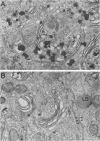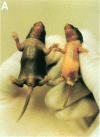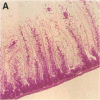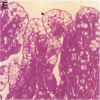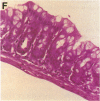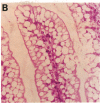Abstract
The formation of chylomicrons by the intestine is important for the absorption of dietary fats and fat-soluble vitamins (e.g., retinol, alpha-tocopherol). Apo B plays an essential structural role in the formation of chylomicrons in the intestine as well as the VLDL in the liver. We have developed genetically modified mice that express apo B in the liver but not in the intestine. By electron microscopy, the enterocytes of these mice lacked nascent chylomicrons in the endoplasmic reticulum and Golgi apparatus. Because these mice could not form chylomicrons, the intestinal villus enterocytes were massively engorged with fat, which was contained in cytosolic lipid droplets. These mice absorbed D-xylose normally, but there was virtually no absorption of retinol palmitate or cholesterol. The levels of alpha-tocopherol in the plasma were extremely low. Of note, the absence of chylomicron synthesis in the intestine did not appear to have a significant effect on the plasma levels of the apo B-containing lipoproteins produced by the liver. The mice lacking intestinal apo B expression represent the first genetic model of defective absorption of fats and fat-soluble vitamins and provide a useful animal model for studying nutrition and lipoprotein metabolism.
Full text
PDF
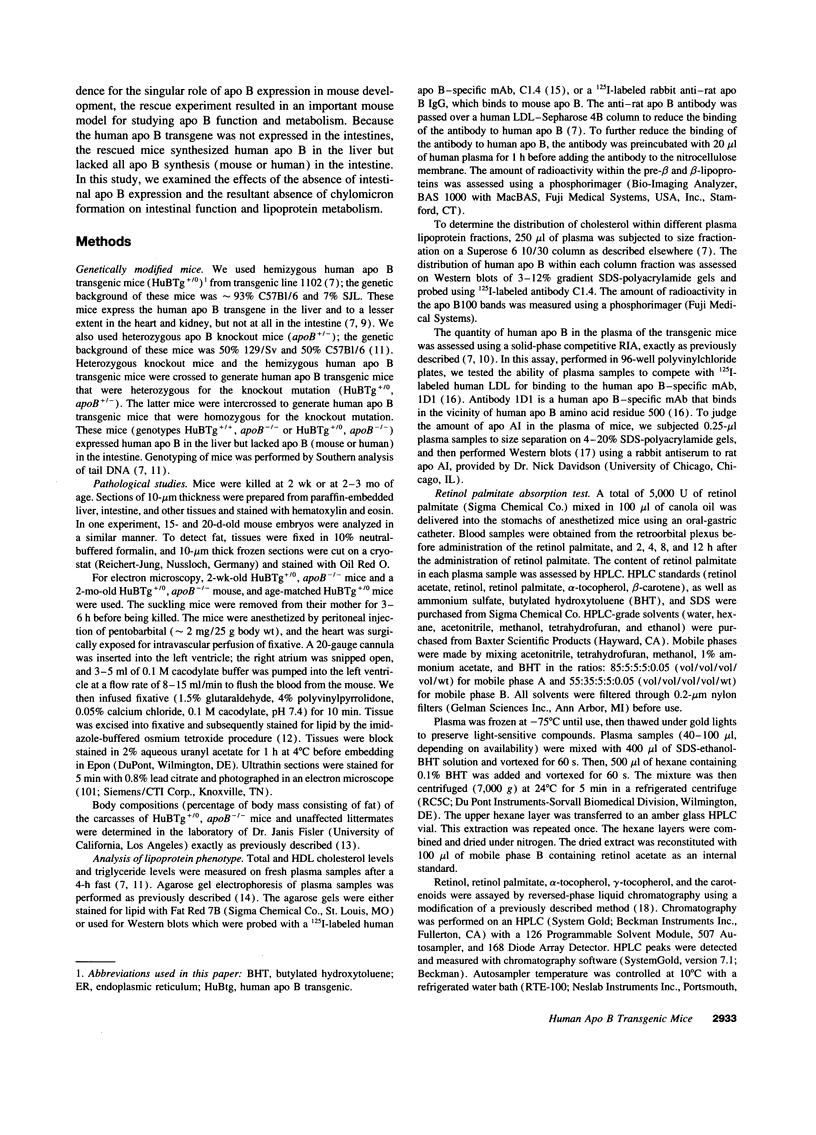
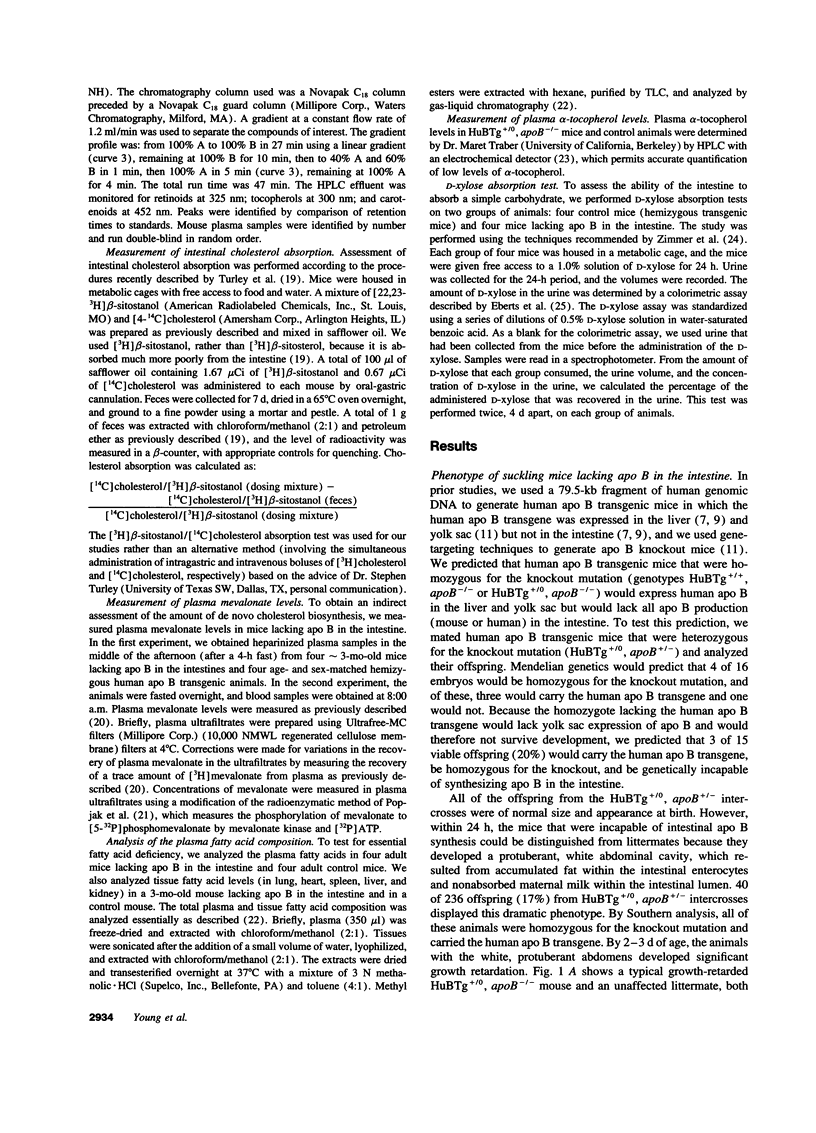

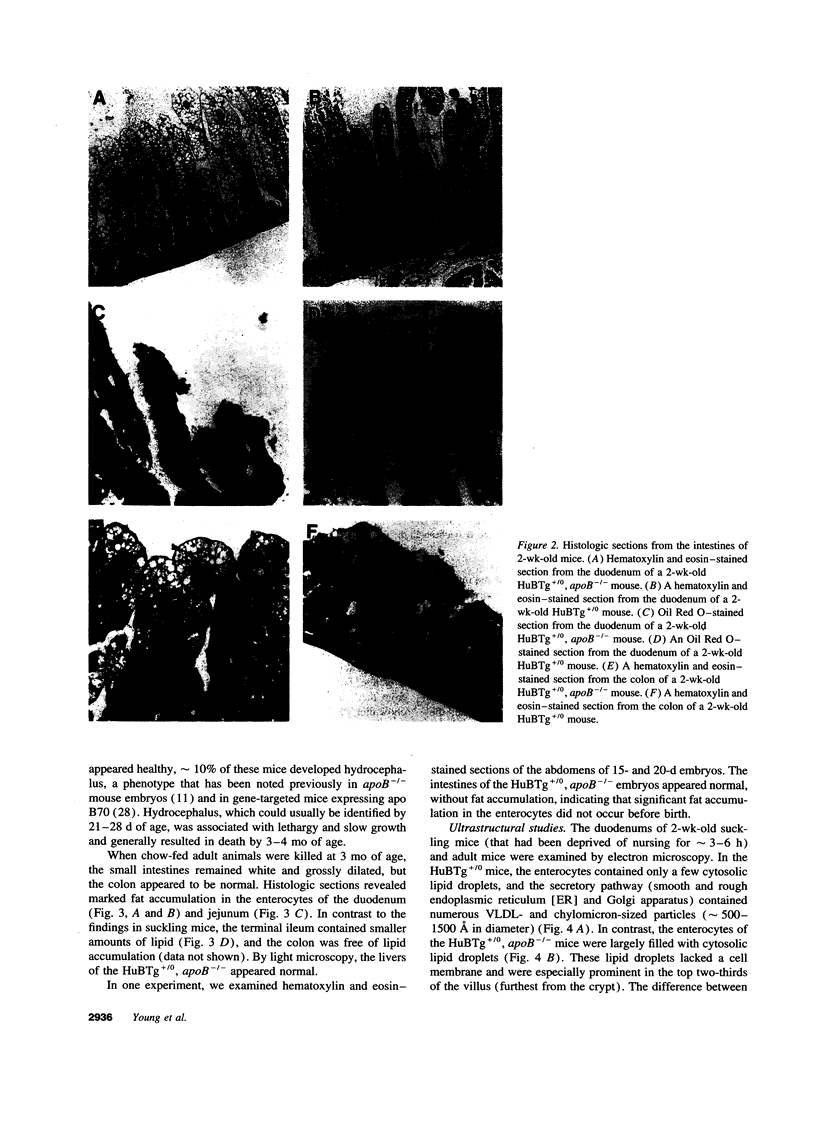

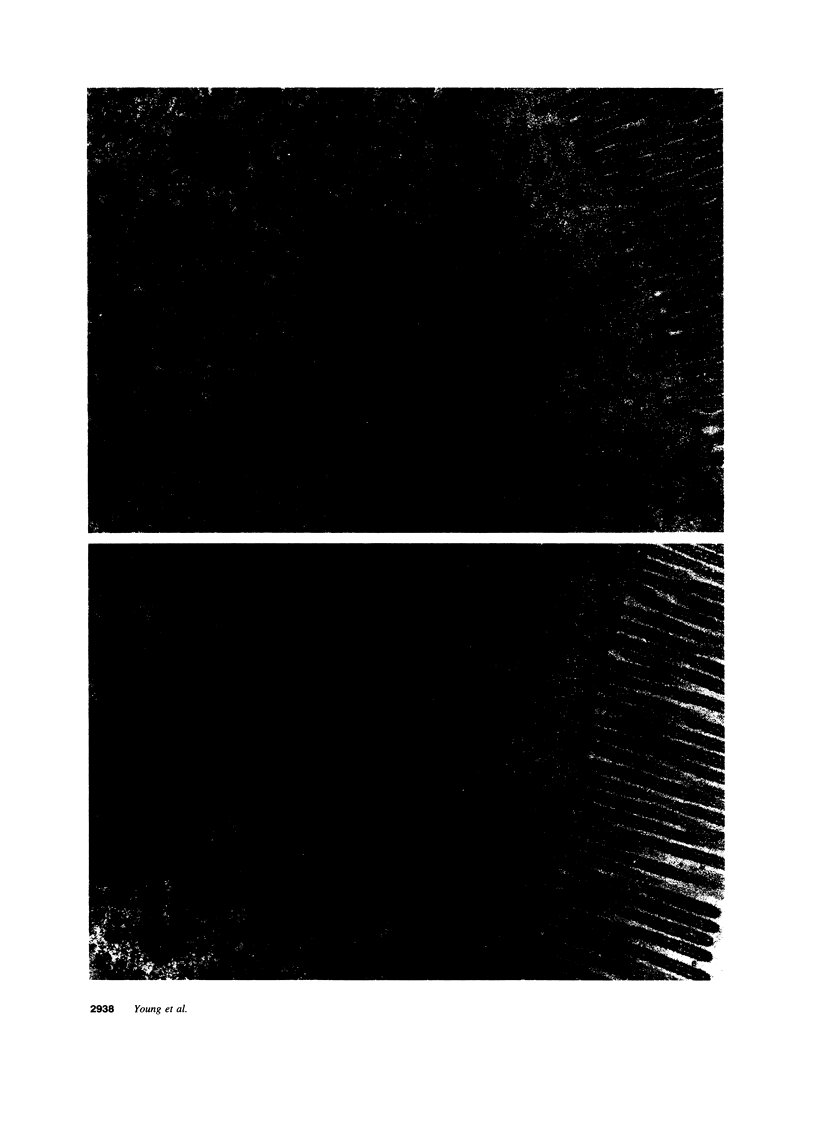
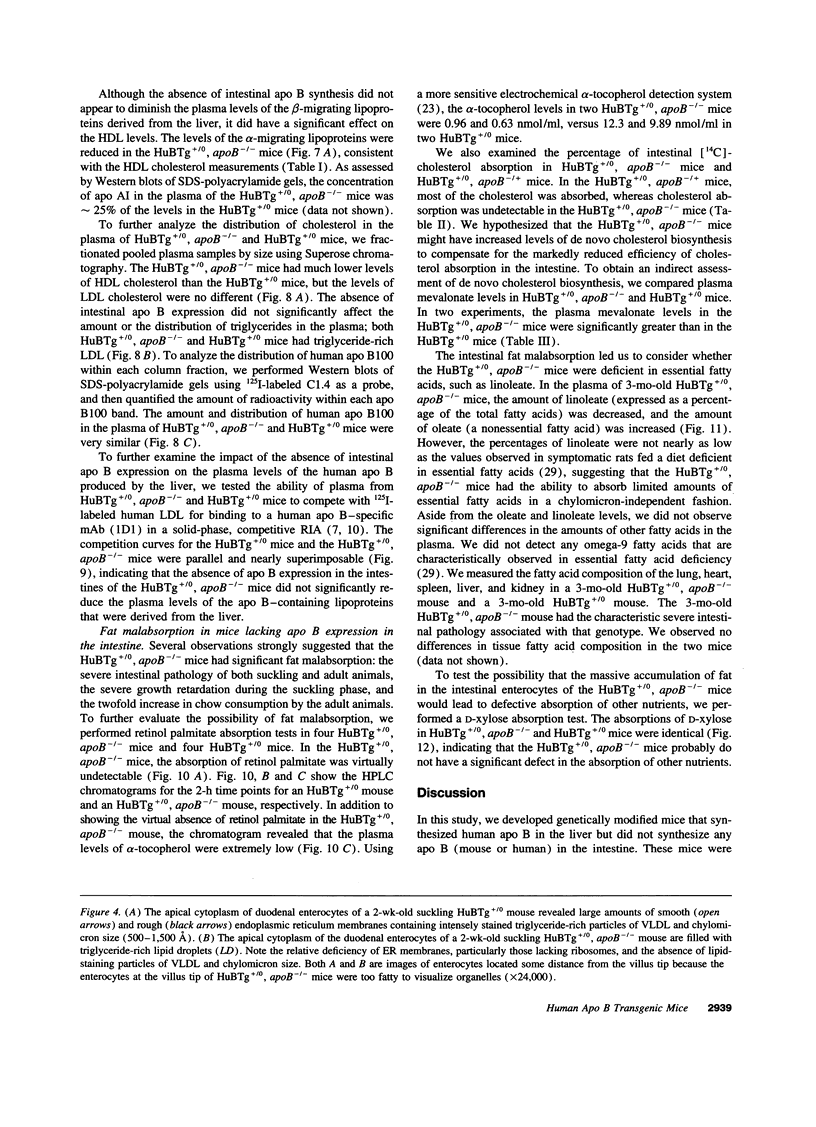
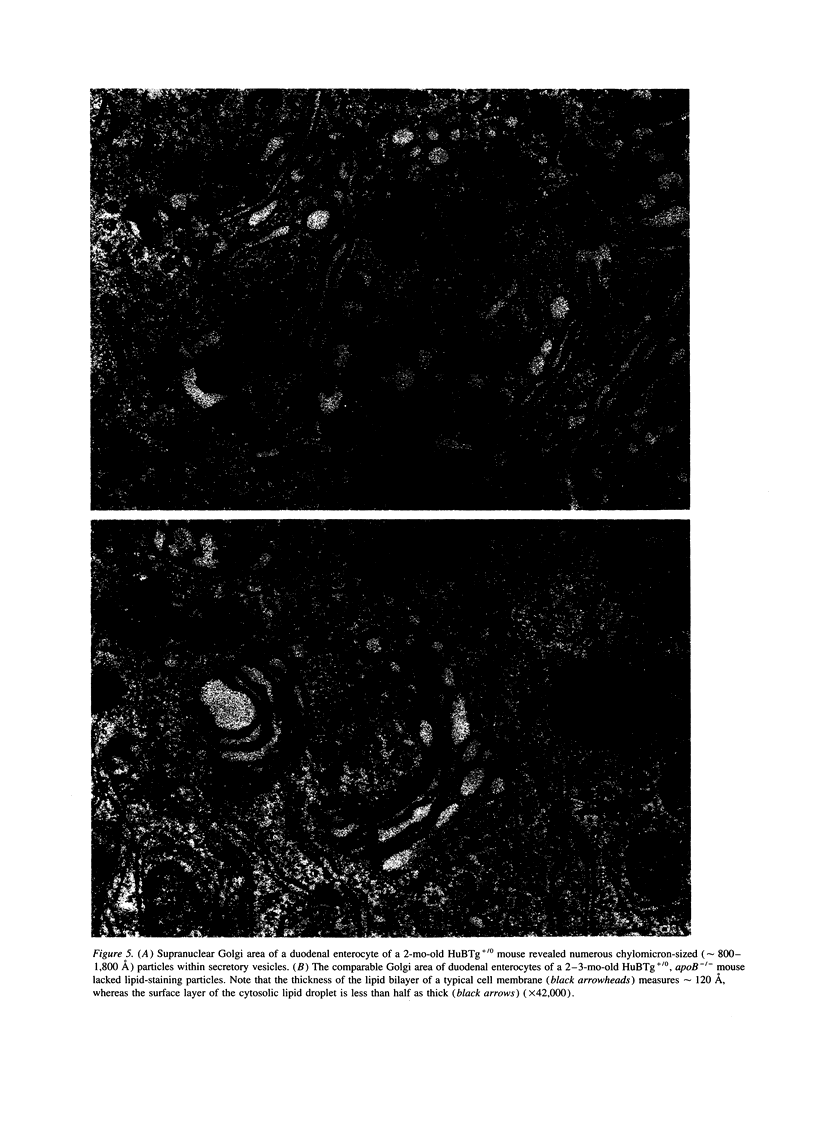


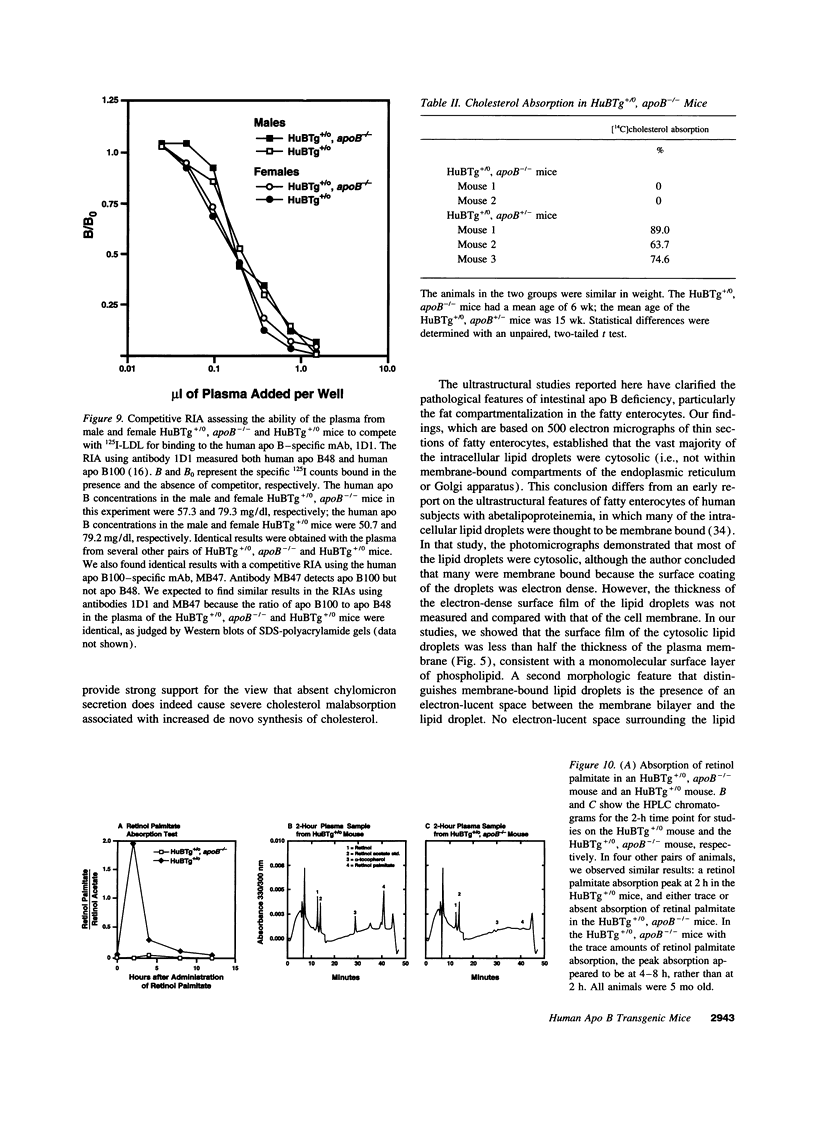
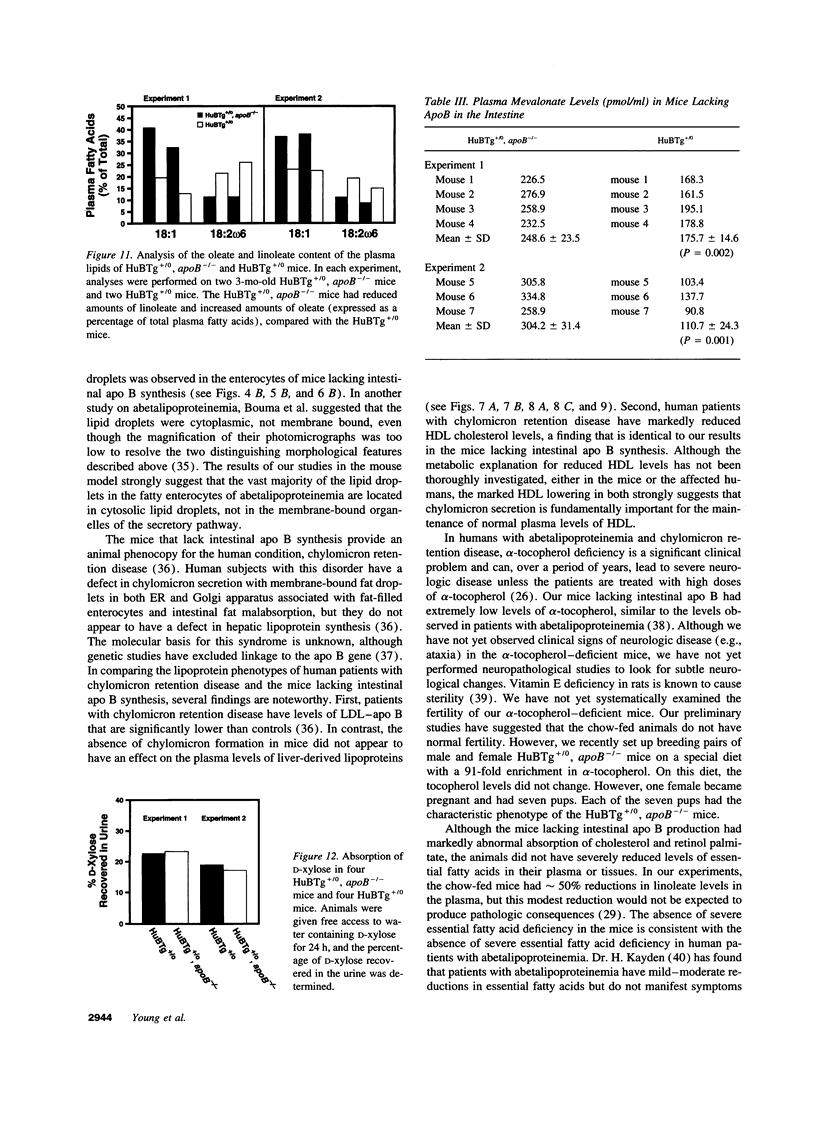

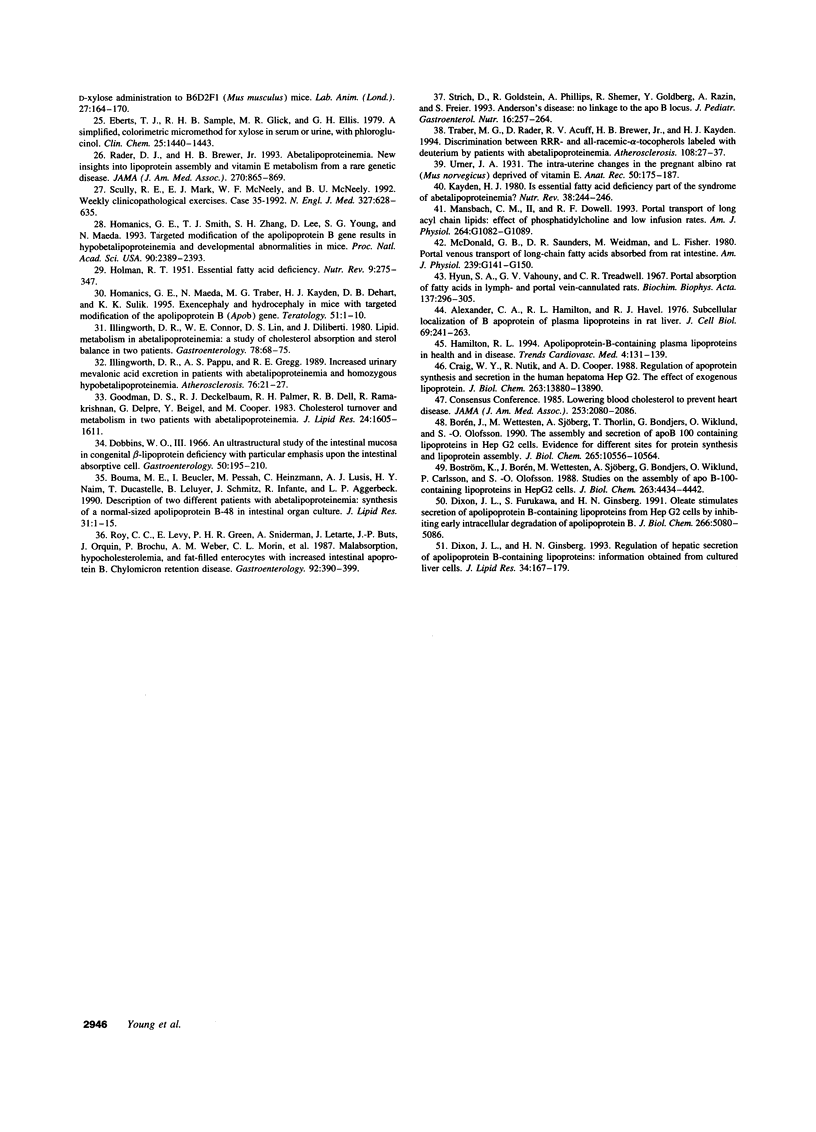
Images in this article
Selected References
These references are in PubMed. This may not be the complete list of references from this article.
- Alexander C. A., Hamilton R. L., Havel R. J. Subcellular localization of B apoprotein of plasma lipoproteins in rat liver. J Cell Biol. 1976 May;69(2):241–263. doi: 10.1083/jcb.69.2.241. [DOI] [PMC free article] [PubMed] [Google Scholar]
- Angermüller S., Fahimi H. D. Imidazole-buffered osmium tetroxide: an excellent stain for visualization of lipids in transmission electron microscopy. Histochem J. 1982 Sep;14(5):823–835. doi: 10.1007/BF01033631. [DOI] [PubMed] [Google Scholar]
- Borén J., Wettesten M., Sjöberg A., Thorlin T., Bondjers G., Wiklund O., Olofsson S. O. The assembly and secretion of apoB 100 containing lipoproteins in Hep G2 cells. Evidence for different sites for protein synthesis and lipoprotein assembly. J Biol Chem. 1990 Jun 25;265(18):10556–10564. [PubMed] [Google Scholar]
- Boström K., Borén J., Wettesten M., Sjöberg A., Bondjers G., Wiklund O., Carlsson P., Olofsson S. O. Studies on the assembly of apo B-100-containing lipoproteins in HepG2 cells. J Biol Chem. 1988 Mar 25;263(9):4434–4442. [PubMed] [Google Scholar]
- Bouma M. E., Beucler I., Pessah M., Heinzmann C., Lusis A. J., Naim H. Y., Ducastelle T., Leluyer B., Schmitz J., Infante R. Description of two different patients with abetalipoproteinemia: synthesis of a normal-sized apolipoprotein B-48 in intestinal organ culture. J Lipid Res. 1990 Jan;31(1):1–15. [PubMed] [Google Scholar]
- Case records of the Massachusetts General Hospital. Weekly clinicopathological exercises. Case 35-1992. An eight-month-old boy with diarrhea and failure to thrive. N Engl J Med. 1992 Aug 27;327(9):628–635. doi: 10.1056/NEJM199208273270909. [DOI] [PubMed] [Google Scholar]
- Craig W. Y., Nutik R., Cooper A. D. Regulation of apoprotein synthesis and secretion in the human hepatoma Hep G2. The effect of exogenous lipoprotein. J Biol Chem. 1988 Sep 25;263(27):13880–13890. [PubMed] [Google Scholar]
- Demmer L. A., Levin M. S., Elovson J., Reuben M. A., Lusis A. J., Gordon J. I. Tissue-specific expression and developmental regulation of the rat apolipoprotein B gene. Proc Natl Acad Sci U S A. 1986 Nov;83(21):8102–8106. doi: 10.1073/pnas.83.21.8102. [DOI] [PMC free article] [PubMed] [Google Scholar]
- Dixon J. L., Furukawa S., Ginsberg H. N. Oleate stimulates secretion of apolipoprotein B-containing lipoproteins from Hep G2 cells by inhibiting early intracellular degradation of apolipoprotein B. J Biol Chem. 1991 Mar 15;266(8):5080–5086. [PubMed] [Google Scholar]
- Dixon J. L., Ginsberg H. N. Regulation of hepatic secretion of apolipoprotein B-containing lipoproteins: information obtained from cultured liver cells. J Lipid Res. 1993 Feb;34(2):167–179. [PubMed] [Google Scholar]
- Eberts T. J., Sample R. H., Glick M. R., Ellis G. H. A simplified, colorimetric micromethod for xylose in serum or urine, with phloroglucinol. Clin Chem. 1979 Aug;25(8):1440–1443. [PubMed] [Google Scholar]
- Farese R. V., Jr, Ruland S. L., Flynn L. M., Stokowski R. P., Young S. G. Knockout of the mouse apolipoprotein B gene results in embryonic lethality in homozygotes and protection against diet-induced hypercholesterolemia in heterozygotes. Proc Natl Acad Sci U S A. 1995 Feb 28;92(5):1774–1778. doi: 10.1073/pnas.92.5.1774. [DOI] [PMC free article] [PubMed] [Google Scholar]
- Fisler J. S., Warden C. H., Pace M. J., Lusis A. J. BSB: a new mouse model of multigenic obesity. Obes Res. 1993 Jul;1(4):271–280. doi: 10.1002/j.1550-8528.1993.tb00621.x. [DOI] [PubMed] [Google Scholar]
- Goodman D. S., Deckelbaum R. J., Palmer R. H., Dell R. B., Ramakrishnan R., Delpre G., Beigel Y., Cooper M. Cholesterol turnover and metabolism in two patients with abetalipoproteinemia. J Lipid Res. 1983 Dec;24(12):1605–1611. [PubMed] [Google Scholar]
- Gregg R. E., Wetterau J. R. The molecular basis of abetalipoproteinemia. Curr Opin Lipidol. 1994 Apr;5(2):81–86. doi: 10.1097/00041433-199404000-00003. [DOI] [PubMed] [Google Scholar]
- Homanics G. E., Maeda N., Traber M. G., Kayden H. J., Dehart D. B., Sulik K. K. Exencephaly and hydrocephaly in mice with targeted modification of the apolipoprotein B (Apob) gene. Teratology. 1995 Jan;51(1):1–10. doi: 10.1002/tera.1420510102. [DOI] [PubMed] [Google Scholar]
- Homanics G. E., Smith T. J., Zhang S. H., Lee D., Young S. G., Maeda N. Targeted modification of the apolipoprotein B gene results in hypobetalipoproteinemia and developmental abnormalities in mice. Proc Natl Acad Sci U S A. 1993 Mar 15;90(6):2389–2393. doi: 10.1073/pnas.90.6.2389. [DOI] [PMC free article] [PubMed] [Google Scholar]
- Hopkins B., Sharpe C. R., Baralle F. E., Graham C. F. Organ distribution of apolipoprotein gene transcripts in 6-12 week postfertilization human embryos. J Embryol Exp Morphol. 1986 Sep;97:177–187. [PubMed] [Google Scholar]
- Hyun S. A., Vahouny V., Treadwell C. R. Portal absorption of fatty acids in lymph- and portal vein-cannulated rats. Biochim Biophys Acta. 1967 Apr 4;137(2):296–305. doi: 10.1016/0005-2760(67)90105-1. [DOI] [PubMed] [Google Scholar]
- Illingworth D. R., Connor W. E., Lin D. S., Diliberti J. Lipid metabolism in abetalipoproteinemia: a study of cholesterol absorption and sterol balance in two patients. Gastroenterology. 1980 Jan;78(1):68–75. [PubMed] [Google Scholar]
- Illingworth D. R., Pappu A. S., Gregg R. E. Increased urinary mevalonic acid excretion in patients with abetalipoproteinemia and homozygous hypobetalipoproteinemia. Atherosclerosis. 1989 Mar;76(1):21–27. doi: 10.1016/0021-9150(89)90190-1. [DOI] [PubMed] [Google Scholar]
- Is essential fatty acid deficiency part of the syndrome of abetalipoproteinemia? Nutr Rev. 1980 Jul;38(7):244–246. doi: 10.1111/j.1753-4887.1980.tb05915.x. [DOI] [PubMed] [Google Scholar]
- Krul E. S., Kleinman Y., Kinoshita M., Pfleger B., Oida K., Law A., Scott J., Pease R., Schonfeld G. Regional specificities of monoclonal anti-human apolipoprotein B antibodies. J Lipid Res. 1988 Jul;29(7):937–947. [PubMed] [Google Scholar]
- Lang J. K., Gohil K., Packer L. Simultaneous determination of tocopherols, ubiquinols, and ubiquinones in blood, plasma, tissue homogenates, and subcellular fractions. Anal Biochem. 1986 Aug 15;157(1):106–116. doi: 10.1016/0003-2697(86)90203-4. [DOI] [PubMed] [Google Scholar]
- Linton M. F., Farese R. V., Jr, Chiesa G., Grass D. S., Chin P., Hammer R. E., Hobbs H. H., Young S. G. Transgenic mice expressing high plasma concentrations of human apolipoprotein B100 and lipoprotein(a). J Clin Invest. 1993 Dec;92(6):3029–3037. doi: 10.1172/JCI116927. [DOI] [PMC free article] [PubMed] [Google Scholar]
- Linton M. F., Farese R. V., Jr, Young S. G. Familial hypobetalipoproteinemia. J Lipid Res. 1993 Apr;34(4):521–541. [PubMed] [Google Scholar]
- Mahley R. W., Palaoğlu K. E., Atak Z., Dawson-Pepin J., Langlois A. M., Cheung V., Onat H., Fulks P., Mahley L. L., Vakar F. Turkish Heart Study: lipids, lipoproteins, and apolipoproteins. J Lipid Res. 1995 Apr;36(4):839–859. [PubMed] [Google Scholar]
- Mansbach C. M., 2nd, Dowell R. F. Portal transport of long acyl chain lipids: effect of phosphatidylcholine and low infusion rates. Am J Physiol. 1993 Jun;264(6 Pt 1):G1082–G1089. doi: 10.1152/ajpgi.1993.264.6.G1082. [DOI] [PubMed] [Google Scholar]
- McCormick S. P., Linton M. F., Young S. G. Expression of P1 DNA in mammalian cells and transgenic mice. Genet Anal Tech Appl. 1994;11(5-6):158–164. doi: 10.1016/1050-3862(94)90036-1. [DOI] [PubMed] [Google Scholar]
- McDonald G. B., Saunders D. R., Weidman M., Fisher L. Portal venous transport of long-chain fatty acids absorbed from rat intestine. Am J Physiol. 1980 Sep;239(3):G141–G150. doi: 10.1152/ajpgi.1980.239.3.G141. [DOI] [PubMed] [Google Scholar]
- Pappu A. S., Illingworth D. R. Diurnal variations in the plasma concentrations of mevalonic acid in patients with abetalipoproteinaemia. Eur J Clin Invest. 1994 Oct;24(10):698–702. doi: 10.1111/j.1365-2362.1994.tb01063.x. [DOI] [PubMed] [Google Scholar]
- Pease R. J., Milne R. W., Jessup W. K., Law A., Provost P., Fruchart J. C., Dean R. T., Marcel Y. L., Scott J. Use of bacterial expression cloning to localize the epitopes for a series of monoclonal antibodies against apolipoprotein B100. J Biol Chem. 1990 Jan 5;265(1):553–568. [PubMed] [Google Scholar]
- Peng Y. S., Peng Y. M. Simultaneous liquid chromatographic determination of carotenoids, retinoids, and tocopherols in human buccal mucosal cells. Cancer Epidemiol Biomarkers Prev. 1992 Jul-Aug;1(5):375–382. [PubMed] [Google Scholar]
- Popják G., Boehm G., Parker T. S., Edmond J., Edwards P. A., Fogelman A. M. Determination of mevalonate in blood plasma in man and rat. Mevalonate "tolerance" tests in man. J Lipid Res. 1979 Aug;20(6):716–728. [PubMed] [Google Scholar]
- Purcell-Huynh D. A., Farese R. V., Jr, Johnson D. F., Flynn L. M., Pierotti V., Newland D. L., Linton M. F., Sanan D. A., Young S. G. Transgenic mice expressing high levels of human apolipoprotein B develop severe atherosclerotic lesions in response to a high-fat diet. J Clin Invest. 1995 May;95(5):2246–2257. doi: 10.1172/JCI117915. [DOI] [PMC free article] [PubMed] [Google Scholar]
- Rader D. J., Brewer H. B., Jr Abetalipoproteinemia. New insights into lipoprotein assembly and vitamin E metabolism from a rare genetic disease. JAMA. 1993 Aug 18;270(7):865–869. doi: 10.1001/jama.270.7.865. [DOI] [PubMed] [Google Scholar]
- Roy C. C., Levy E., Green P. H., Sniderman A., Letarte J., Buts J. P., Orquin J., Brochu P., Weber A. M., Morin C. L. Malabsorption, hypocholesterolemia, and fat-filled enterocytes with increased intestinal apoprotein B. Chylomicron retention disease. Gastroenterology. 1987 Feb;92(2):390–399. doi: 10.1016/0016-5085(87)90133-8. [DOI] [PubMed] [Google Scholar]
- Shi W. K., Heath J. K. Apolipoprotein expression by murine visceral yolk sac endoderm. J Embryol Exp Morphol. 1984 Jun;81:143–152. [PubMed] [Google Scholar]
- Strich D., Goldstein R., Phillips A., Shemer R., Goldberg Y., Razin A., Freier S. Anderson's disease: no linkage to the apo B locus. J Pediatr Gastroenterol Nutr. 1993 Apr;16(3):257–264. [PubMed] [Google Scholar]
- Traber M. G., Rader D., Acuff R. V., Brewer H. B., Jr, Kayden H. J. Discrimination between RRR- and all-racemic-alpha-tocopherols labeled with deuterium by patients with abetalipoproteinemia. Atherosclerosis. 1994 Jul;108(1):27–37. doi: 10.1016/0021-9150(94)90035-3. [DOI] [PubMed] [Google Scholar]
- Turley S. D., Daggy B. P., Dietschy J. M. Psyllium augments the cholesterol-lowering action of cholestyramine in hamsters by enhancing sterol loss from the liver. Gastroenterology. 1994 Aug;107(2):444–452. doi: 10.1016/0016-5085(94)90170-8. [DOI] [PubMed] [Google Scholar]
- Young S. G., Bertics S. J., Curtiss L. K., Witztum J. L. Characterization of an abnormal species of apolipoprotein B, apolipoprotein B-37, associated with familial hypobetalipoproteinemia. J Clin Invest. 1987 Jun;79(6):1831–1841. doi: 10.1172/JCI113025. [DOI] [PMC free article] [PubMed] [Google Scholar]
- Young S. G., Bertics S. J., Scott T. M., Dubois B. W., Curtiss L. K., Witztum J. L. Parallel expression of the MB19 genetic polymorphism in apoprotein B-100 and apoprotein B-48. Evidence that both apoproteins are products of the same gene. J Biol Chem. 1986 Mar 5;261(7):2995–2998. [PubMed] [Google Scholar]
- Young S. G., Farese R. V., Jr, Pierotti V. R., Taylor S., Grass D. S., Linton M. F. Transgenic mice expressing human apoB100 and apoB48. Curr Opin Lipidol. 1994 Apr;5(2):94–101. doi: 10.1097/00041433-199404000-00005. [DOI] [PubMed] [Google Scholar]
- Young S. G. Recent progress in understanding apolipoprotein B. Circulation. 1990 Nov;82(5):1574–1594. doi: 10.1161/01.cir.82.5.1574. [DOI] [PubMed] [Google Scholar]



